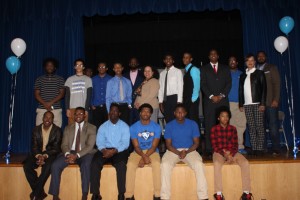On Wednesday, January 27, 2016, the male students of the African American Male Initiative (AAMI) met a difficult deadline and presented a 20+ minute documentary to fellow students of Booker T. Washington high school in Atlanta, Georgia. The students were led by Tene Davis, Cedrick Dortch, and Jason Moore of the Crim Center of Geo rgia State University. The young men were began the process of filmmaking at the beginning of the fall semester 2015. They learned quickly that the process of making a film was not as easy as it appeared. The students broke up into groups whereby some operated the cameras, others conducted interviews, a few did research, all participated in the editing process, and some even performed original music. The work was not easy or simple. The young men met 3 to 4 times a week after school as well Saturday mornings. Overtime they met, they began and ended their meetings with a missions statement that helped to bond them all. As the winter break came upon them, they realized that it would take extra hours to complete the film by the January 27 deadline.
rgia State University. The young men were began the process of filmmaking at the beginning of the fall semester 2015. They learned quickly that the process of making a film was not as easy as it appeared. The students broke up into groups whereby some operated the cameras, others conducted interviews, a few did research, all participated in the editing process, and some even performed original music. The work was not easy or simple. The young men met 3 to 4 times a week after school as well Saturday mornings. Overtime they met, they began and ended their meetings with a missions statement that helped to bond them all. As the winter break came upon them, they realized that it would take extra hours to complete the film by the January 27 deadline.
I met with the Crim Center team in November of 2015 and agreed to come on as a consultant for the  project. I instructed the students to break the film down into themes and to allow each theme to
project. I instructed the students to break the film down into themes and to allow each theme to
stand alone as a movie by itself. In my few meetings I observed the young men growing as filmmakers and bonding together to complete every task. I was not able to meet with them after the start of the new y
ear so when I showed up for the premiere I really did not know what to expect.Walking into the auditorium was a wonde
rful surprise. The red carpet was in front of the door, the young men were dressed in either shirt and tie or in uniforms. They greeted every guest at the door and made everyone feel like it was a premiere that was worth while. Once the film began, I was truly taken aback by the quality and professionalism. The intro of the film was very strong and compelling. I had advised them to break the film into themes and they  came up with a way to express
came up with a way to express
the various sections as a student driven film that connected with the past, present and a direction for the future. The film had complete control over the audience. People laughed at the funny parts, they learned about Booker T. Washington, and they also learned of all the legendary leaders that had attended the school. After the film, the students conducted a panel discussion and gave insightful responses to audience questions.
 I am really proud to have been introduced to the Crim Center by the SIF program (Brennan Collins), as well as consult with the young men of AAMI. The Booker T. Washington documentary was a complete success and I can see this film being played in film festivals a
I am really proud to have been introduced to the Crim Center by the SIF program (Brennan Collins), as well as consult with the young men of AAMI. The Booker T. Washington documentary was a complete success and I can see this film being played in film festivals a
nd on television in the near future. I think that the hands on strategy proved to work for the young males and I hope that more programs like this can be developed for more high school students in the future.

Ameer, reads like a great program that happened just the other day. Congratulations on this achievement.
What is the “Crim Center”? It sounds interesting.
The Alonzo A. Crim Center for urban educational excellence housed at Georgia State University has a mission to optimize the life opportunities of children and families in urban communities by ensuring the availability of a prosperous and equitable school environment through community engagement, research and educational development and support. Here is the website: http://crim.education.gsu.edu/